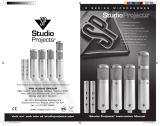3
Operating the C01
Powering the C01
The C01 is a condenser microphone and therefore needs to be operated by
connecting a phantom power supply. Phantom power is standard on most quali-
ty mixers, outboard mic-pres and hard disk recorders. If necessary an external
phantom supply can also be used. The C01 receives the phantom power directly
from a mic cable when connected to a mixer or other microphone input that
includes a phantom supply. The power is actually sent OUT of the microphone
INPUT, riding silently along with the audio signal. (Fairly mysterious, eh?) Most
mixers have a switch to engage the phantom power so be sure to check that the
phantom power is on. The C01 features a blue LED, which will illuminate when
phantom power is present.
Polar Pattern
The most important characteristic of any microphone is its directionality or “pick-
up pattern”. There are three basic categories of pick up patterns; omni, bi and
uni-directional. Omni mics pick up sound from all directions, bi-directional (fig-
ure 8) mics pick up the sound directly in front and back of the microphone while
rejecting the sound on the left and right sides, and uni-directional (cardioid) mics
pick up the sound in front of the microphone.
While omni and bi-directional microphones are very useful for a variety of appli-
cations, the majority of micing situations in recording and live sound require uni-
directional or cardioid microphones. The uni-directional nature allows for better
separation of instruments in the studio and more control over feedback in live
sound reinforcement. The C01 condenser’s pick-up pattern is hyper-cardioid,
which offers even more side-to-side rejection. When positioned correctly the
hyper-cardioid pick-up pattern allows you to pick up more of the sound you want
and less of the sound you don’t want.
Microphone Placement
In order to maximize the sound quality, you must pay careful attention to the
placement of your C01 and how it is positioned for the instrument or vocalist
that you are micing. All microphones, especially uni-directional or cardioid micro-
phone exhibit a phenomenon known as proximity effect. Very simply put, prox-
imity effect is a resulting change in the frequency response of a microphone
based on the position of the mic capsule relative to the sound source.
Specifically, when you point a cardioid mic directly at the sound source (on axis)
you will get the best frequency response, however when you start pointing the
microphone slightly away (off axis) you will notice the low frequency response
dropping off and the microphone will start to sound thinner.
For most vocals application you’ll want to position the microphone directly in
front of the talent. The same may be true for micing instruments, however, you
ENGLISH








